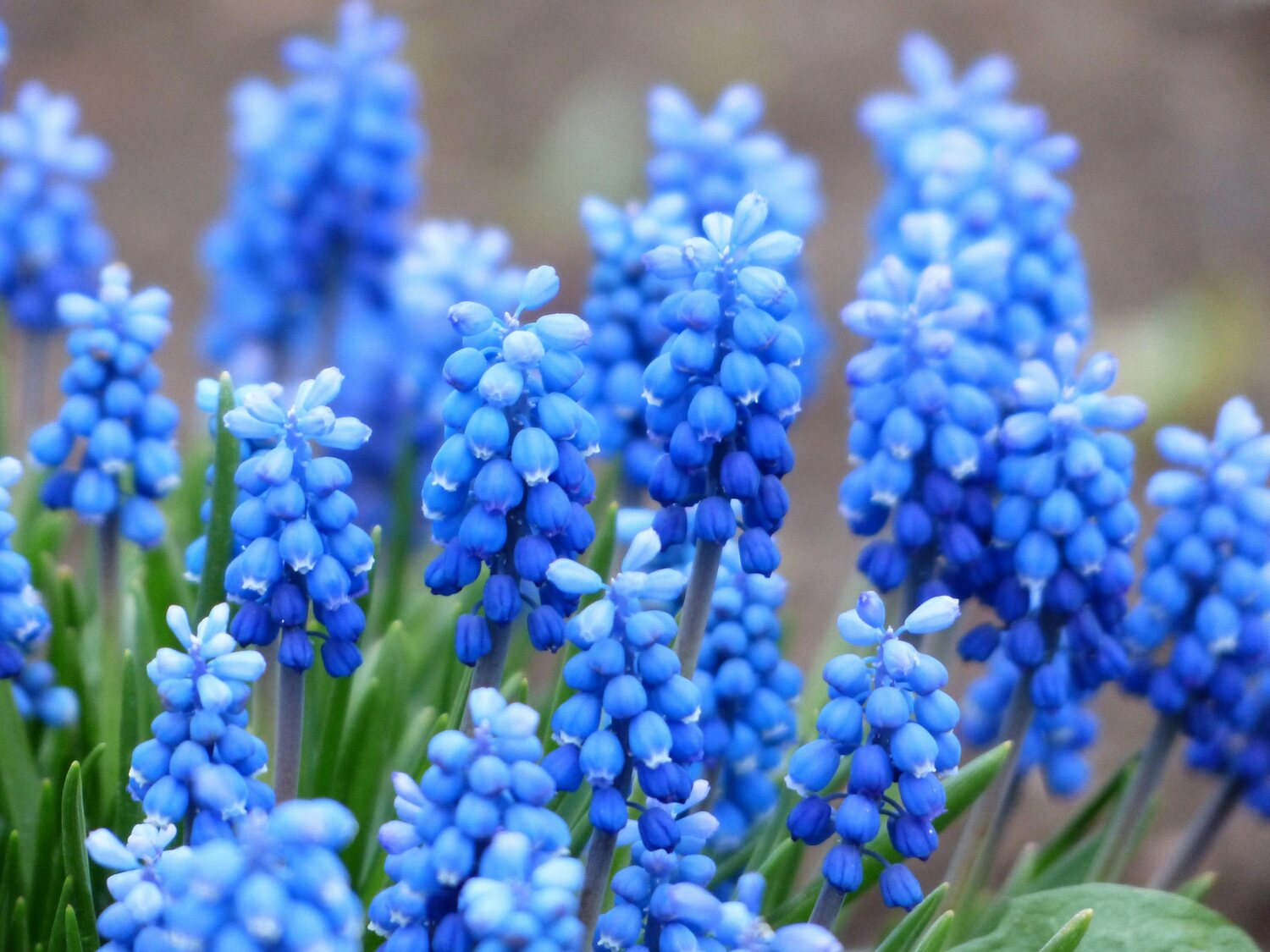Without proper preparation, planting muscari bulbs in areas with warmer climates may result in weak foliage and dormant buds. This is why we pre-chill our muscari buds to encourage growth in any climate. Discover how controlled growth with pre-chilled muscari in warm climates can give you beautiful spring blooms even in hot regions.
Controlled Growth With Pre-Chilled Muscari in Warm Climates
Pre-chilled muscari involves artificially providing the cold treatment these bulbs require to trigger proper flowering in regions that lack sufficient winter chill hours. This technique enables gardeners in warm zones to successfully cultivate these beloved spring bulbs by mimicking their natural dormancy cycle through refrigeration before planting.

With this method, you can enjoy spring muscari blooms, even where winters are too warm for natural chilling. Additionally, understanding chilling, soil requirements, and maintenance techniques yields better results with muscari.
1. Understanding Muscari and Their Unique Growth Habits
Muscari offers a reliable spring color and is easy to manage. If you want steady growth and blooms, it helps to understand their growth needs, especially in warm climates.
Recognizing What Makes Muscari Ideal for Warm Climates
Muscari bulbs are small, hardy, and surprisingly adaptable. These are the notable traits of muscari that help them grow in warm climates:
- Adaptability: While naturally suited for cold winters, muscari bulbs respond exceptionally well to artificial vernalization (chilling), making them highly amenable to controlled growth environments.
- Aesthetic appeal: They offer the unique opportunity to introduce traditional spring beauty, often associated with temperate zones, into warmer landscapes.
- Container gardening suitability: Muscari thrives in containers, which is a significant advantage for warm-climate gardeners. Containers allow for precise control over soil conditions, moisture, and temperature regulation by moving them as needed.
Identifying Muscari Species and Varieties Suited to Controlled Growth
You’ll find several muscari species that work well for container gardens and gardens with limited space. These benefit from pre-chilling as the simulated winter conditions effectively break their dormancy, enabling their flowers to emerge reliably even in warm climates.
- Muscari Armeniacum
- Muscari Botryoides
- Muscari Azureum
- Muscari Latifolium
- Muscari Valerie Finnis
2. Pre-Chilling Muscari Bulbs for Successful Flowering
Muscari needs cold weather to bloom well. In warm climates, you can create the right environment by pre-chilling bulbs before planting for better flower growth, reliable bloom time, and strong stems.

Understanding Why Pre-Chilling Is Needed in Warm Regions
Muscari bulbs, like many spring-flowering bulbs, require a specific period of cold temperatures to break dormancy and develop flower buds. Without this cold exposure, the bulbs will primarily produce foliage and may rarely bloom.
In warm climates, natural winter chill hours are insufficient. Pre-chilling artificially provides these necessary cold temperatures, signaling to the bulb it's time to prepare for spring blooming.
Implementing Pre-Chilling Methods for Optimal Bloom
To pre-chill muscari bulbs on your own, you need to place them in a breathable paper bag and keep them in your refrigerator, not the freezer. However, this can take weeks of monitoring, and failing to do so can damage the bulbs.
Aside from not meeting the minimum 10-week chilling period, inconsistent temperatures and improper moisture can cause bulbs to rot. Even ethylene gas exposure due to storing bulbs near ripening fruits can inhibit flowering.
This is why most nurseries and gardens use dedicated cold storage units to provide precise temperature and humidity control.
3. Planting and Growing Muscari in Warm Climates
Just like how daffodils can thrive in the south, muscari bulbs can thrive in warm climates as well with proper cooling, correct soil, and careful moisture control. Following clear steps helps you grow healthy grape hyacinths, even when winters are mild.
|
Factor |
Details |
|
Pre-chilling |
10-14 weeks at 35-45 degrees Fahrenheit |
|
Soil requirements |
Well-draining, loose soil, enriched with organic matter |
|
Moist |
Moist yet not waterlogged |
|
Light |
Partial sun preferred, tolerates full sun |
|
Planting depth |
3-4 inches deep |
|
Container growing |
Excellent option, especially for indoor growing |
|
Timing |
Plant when the soil temperature drops to 60 degrees Fahrenheit |
|
Post-bloom care |
Allow foliage to die back naturally |
Selecting and Preparing Muscari Bulbs
This initial stage promotes bulb viability and activates their blooming potential through proper chilling and selection.
- Choose firm, healthy bulbs and pre-chill them.
- Select containers with good drainage if you plan for potted growth.
- Opt for larger bulbs to encourage bigger and fuller blooms.

Following Planting Depth and Timing for Controlled Growth
Strategic planting depth and controlled bulb timing establish a robust root system and align with Muscari's natural growth cycle after chilling.
- Plant pre-chilled bulbs about 3 inches deep with the pointed end up and 3 inches apart, either in the fall (2-4 weeks before the first frost) or once night temperatures drop below 60 degrees Fahrenheit.
- If immediate outdoor planting isn't feasible, store pre-chilled bulbs in a cool place.
- For very warm regions, prioritize container planting to better control the growing environment.
Choosing the Ideal Soil Types and Soil Amendments
Providing the correct soil type and amendments prevents rot and supports healthy bulb development.
- Prepare well-drained soil, using sandy or loamy types, or amend heavy clay with organic matter, like compost or leaf mold.
- For containers, use a high-quality, well-draining potting mix, optionally enhanced with sand or perlite.
- Avoid high-nitrogen fertilizers, which can hinder flower production.
Managing Watering and Moisture Management
Consistent yet not excessive moisture is key to successful muscari growth, supporting the plant's needs through its active and dormant phases.
- Water bulbs immediately after planting and then maintain consistently moist soil.
- Regularly check soil moisture levels, especially in containers, and reduce watering once foliage yellows and bulbs enter dormancy.
- Avoid overhead watering to minimize the risk of fungal issues.
Related Questions
Do Muscari Bulbs Need to be Chilled?
Muscari bulbs require a cold treatment period of at least 10 weeks at temperatures between 35-45 degrees Fahrenheit to break dormancy and initiate proper flowering. Without this chilling period, the bulbs may produce foliage, although they typically won't bloom or may produce very weak flowers.
What Are the Best Growing Conditions for Muscari?
Muscari thrives in well-draining soil with full sun to partial shade and prefers cool, moist conditions during their active growing season in spring. If you live in a region with mild winters, plant your pre-chilled bulbs in late winter or early spring.
What Is the Best Way to Maintain Muscari in Warm Regions?
To maintain muscari in warm regions, plant them in well-draining, slightly alkaline soil. Water them regularly during their growing season while letting the foliage die back naturally after blooming.
Conclusion
Controlled growth with pre-cooled muscari gives you reliable blooms and more gardening options, even in challenging gardening environments. Try our pre-chilled muscari for your next warm-climate planting and see the difference in your garden.


